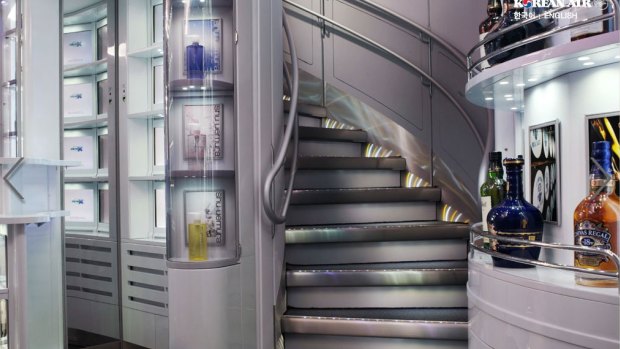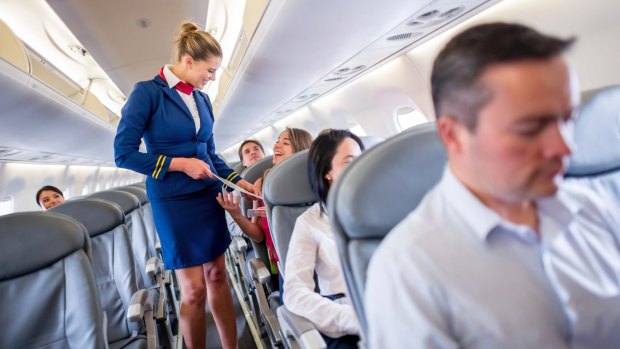This was published 7 years ago
Why do airlines still offer inflight duty-free on board?
By Michael Gebicki

Korean Air A380 duty free on board shop.
The duty-free cart rumbles down the aisle of your international flight, packed with perfumes and liquor, watches, RFID (Radio Frequency IDentification) safe wallets, adapters and other travel must-haves. The cabin crew manning the cart look hopefully left and right and if it's anything like a typical flight, the cart gets to the end of the cabin without making a single sale.
Why do airlines continue with inflight duty-free sales? There are plenty of opportunities for duty-free shopping at airline terminals, often there are refund schemes that allow shoppers to buy at high street outlets, and even at home in the case of Australia, and claim the tax back. The duty-free carts require a capital investment, they add weight, and airlines are constantly looking at ways to fly slimmer, and the choice is nothing like as bountiful as what you get from a duty-free shop in most airport terminals. So why do airline duty-free sales even exist?
The short answer is that for some airlines at least, inflight duty-free sales are big money spinners. In 2015, GuestLogix, which at the time was processing on-board duty-free sales, put the annual figure for on-board duty-free sales in excess of US$3 billion. According to GuestLogix, skincare products, makeup and perfumes were the most popular items, followed by jewellery, watches, alcohol and cigarettes. Some airlines were said to be turning over between $100-$200 million every year in inflight duty-free sales, but it's a mixed picture depending broadly on where the airline calls home.

Airlines still offer passengers the option to duty-free shop onboard.Credit: iStock
See also: Top 10 air travel facts about emergency equipment, safety and food
At one end of the scale is Korean Air, which has installed Sky Shops aboard its 10-strong fleet of A380 aircraft. Sky Shops are mini malls in the sky, walk-in boutiques stocked with cosmetics, perfumes, liquor, fashion goods, pearls, dietary supplements, chocolates, watches, electronics and pens. Underlining the airline's dedication to the concept, the Sky Shop sacrifices 13 of the A380s seats, a bold move when most airlines are shaving centimetres off every possible space to squeeze in another body.
According to Guestlogix, Scandinavians are inclined to buy more duty-free items inflight than other Europeans. VAT in Norway, Denmark and Sweden on just about every item you might buy from on-board duty-free is a hefty 25 per cent, one per cent less in Finland. That's around five per cent higher than most other EU countries, and goes some way towards explaining their greater enthusiasm. Asian and Middle Eastern carriers also report a more animated audience for on-board duty-free shopping.
At the opposite extreme, Delta Air Lines ditched its duty-free sales totally in 2014. American Airlines did the same less than a year later. Both airlines blamed it on disputes with DFASS, the duty-free vendor they used in common, but at the root of the problem the carriers were not able to offer goods that passengers wanted to buy at a reasonable price against the USA's super competitive retail environment.
See also: Why airlines won't tell you what's really in your plane food?
Many of the airlines still dedicated to the cause of inflight shopping are moving to make it a more streamlined, personalised experience. Some are transitioning from the old style seat back shopping catalogues in favour of shopping over the inflight entertainment system. Several airlines encourage passengers to shop for duty-free products from their website pre-flight, with the goods delivered on-board, or even direct to the home.
The next mutation in inflight shopping might be using big data to offer a customised shopping experience. If your browsing history reveals an interest in designer handbags, or headphones, or a particular clothing brand, you could find those items popping up when you fire up your inflight entertainment system, against a background of your favourite music as determined by Spotify. Amazon already uses similar analytics to feed shoppers' appetites when they're surfing on third party websites. That might extend the inflight shopping adventure well beyond the realms of duty-free. If you're on a flight returning from the AFL Grand Final in Melbourne, your airline might be privy to that information, so what about a supporter's polo shirt, or congratulations on the big win for your team, why not sign up for a season pass for next year? If airlines can curate a shopping experience without annoying passengers they probably will, and ancillary revenues are becoming ever more meaningful for airlines.
Sign up for the Traveller newsletter
The latest travel news, tips and inspiration delivered to your inbox. Sign up now.